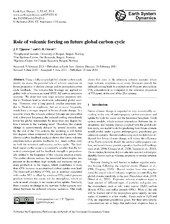| dc.description.abstract | Using a fully coupled global climate-carbon cycle model, we assess the potential role of volcanic eruptions on future projection of climate change and its associated carbon cycle feedback. The volcanic-like forcings are applied together with a business-as-usual IPCC-A2 carbon emissions scenario. We show that very large volcanic eruptions similar to Tambora lead to short-term substantial global cooling. However, over a long period, smaller eruptions similar to Pinatubo in amplitude, but set to occur frequently, would have a stronger impact on future climate change. In a scenario where the volcanic external forcings are prescribed with a five-year frequency, the induced cooling immediately lower the global temperature by more than one degree before it returns to the warming trend. Therefore, the climate change is approximately delayed by several decades, and by the end of the 21st century, the warming is still below two degrees when compared to the present day period. Our climate-carbon feedback analysis shows that future volcanic eruptions induce positive feedbacks (i.e., more carbon sink) on both the terrestrial and oceanic carbon cycle. The feedback signal on the ocean is consistently smaller than the terrestrial counterpart and the feedback strength is proportionally related to the frequency of the volcanic eruption events. The cooler climate reduces the terrestrial heterotrophic respiration in the northern high latitude and increases net primary production in the tropics, which contributes to more than 45 % increase in accumulated carbon uptake over land. The increased solubility of CO2 gas in seawater associated with cooler SST is offset by a reduced CO2 partial pressure gradient between the ocean and the atmosphere, which results in small changes in net ocean carbon uptake. Similarly, there is nearly no change in the seawater buffer capacity simulated between the different volcanic scenarios. Our study shows that even in the relatively extreme scenario where large volcanic eruptions occur every five-years period, the induced cooling leads to a reduction of 46 ppmv atmospheric CO2 concentration as compared to the reference projection of 878 ppmv, at the end of the 21st century. | en_US |

